This article has been reviewed according to Science X's editorial process and policies. Editors have highlighted the following attributes while ensuring the content's credibility:
fact-checked
peer-reviewed publication
trusted source
proofread
Current level of rainfall recharging groundwater in southwest Australia at its lowest for the last 800 years: Study

In a world-first study, Australian environmental scientists have used cave stalagmites as a record of groundwater replenishment over time, that showed the current level of rainfall recharging groundwater in southwest WA is at its lowest for at least the last 800 years.
The evidence indicated that there has been a decline in rainfall recharge to groundwater in southwest Australia over the last 20 years due to reduced rainfall.
This scientific development was achieved by using stalagmites and ceiling dripwater from caves that are located between the land surface and the groundwater table. The research has been published in Communications Earth & Environment.
Water that filters through the cave from the surface towards the groundwater can form cave stalagmites. These stalagmites can be used to obtain records of past groundwater replenishment (technically known as recharge) using the oxygen isotopic composition (δ18O). The stalagmites collected in this study indicated that rainfall recharge to groundwater has declined in response to the rainfall reduction.
Prof. Andy Baker, School of Biological Earth and Environmental Sciences (UNSW) and co-author, said the most compelling aspect of the study was watching this groundwater record evolve over the last few years as more and more stalagmite data was compiled.
"Our work confirmed that records from the most recent decades were unprecedented. This approach opens a new 'toolbox' for using stalagmites to provide records of groundwater recharge in the past. The capability will allow us to better understand how to sustainably manage our groundwater resource in the future."
The research was devised and led by Dr. Stacey Priestley, (formerly of ANSTO and University of Adelaide, who is now at CSIRO) and Dr. Pauline Treble (senior research scientist at ANSTO).
"By analyzing (δ18O) in stalagmites, we can assess how rainfall recharge rates have changed over even longer time periods," said Dr. Priestley.
Dr. Pauline Treble explained that the Southwest Australia region is dependent on groundwater to meet approximately 75% of its water demand. "The research highlights the vulnerability of this resource," Dr. Treble said.
As the current record only goes back 800 years, work will continue to extend it back further in time.
"We are now working towards extending the record to 10,000 years ago, to understand when groundwater was recharged and under what past climate scenarios this occurred. This means we can better understand the limits and sustainability of this valuable resource for communities that rely heavily on groundwater," said Dr. Priestley.
The investigators used the X‐ray fluorescence microscopy (XFM) beamline at the ANSTO's Australian Synchrotron to map the strontium for the CRY-S1 chronology.
The authors respectfully acknowledge the Wadandi Noongar peoples as the traditional and spiritual custodians of the study region.
More information: Stacey C. Priestley et al, Caves demonstrate decrease in rainfall recharge of southwest Australian groundwater is unprecedented for the last 800 years, Communications Earth & Environment (2023). DOI: 10.1038/s43247-023-00858-7
Journal information: Communications Earth & Environment




















